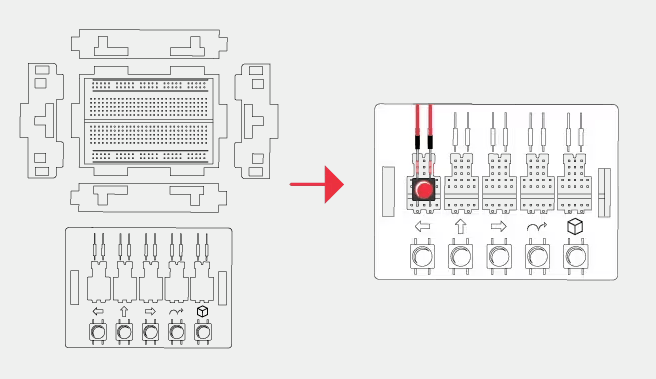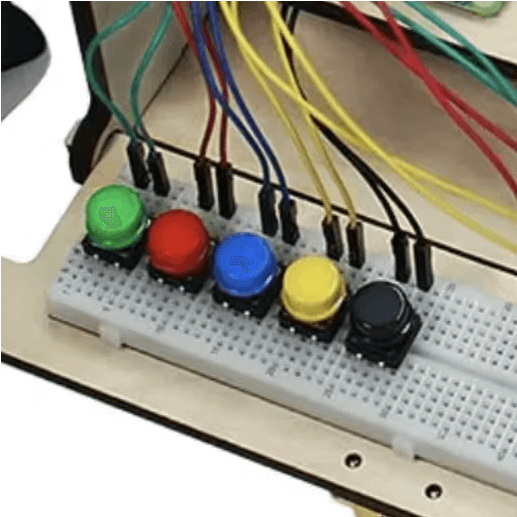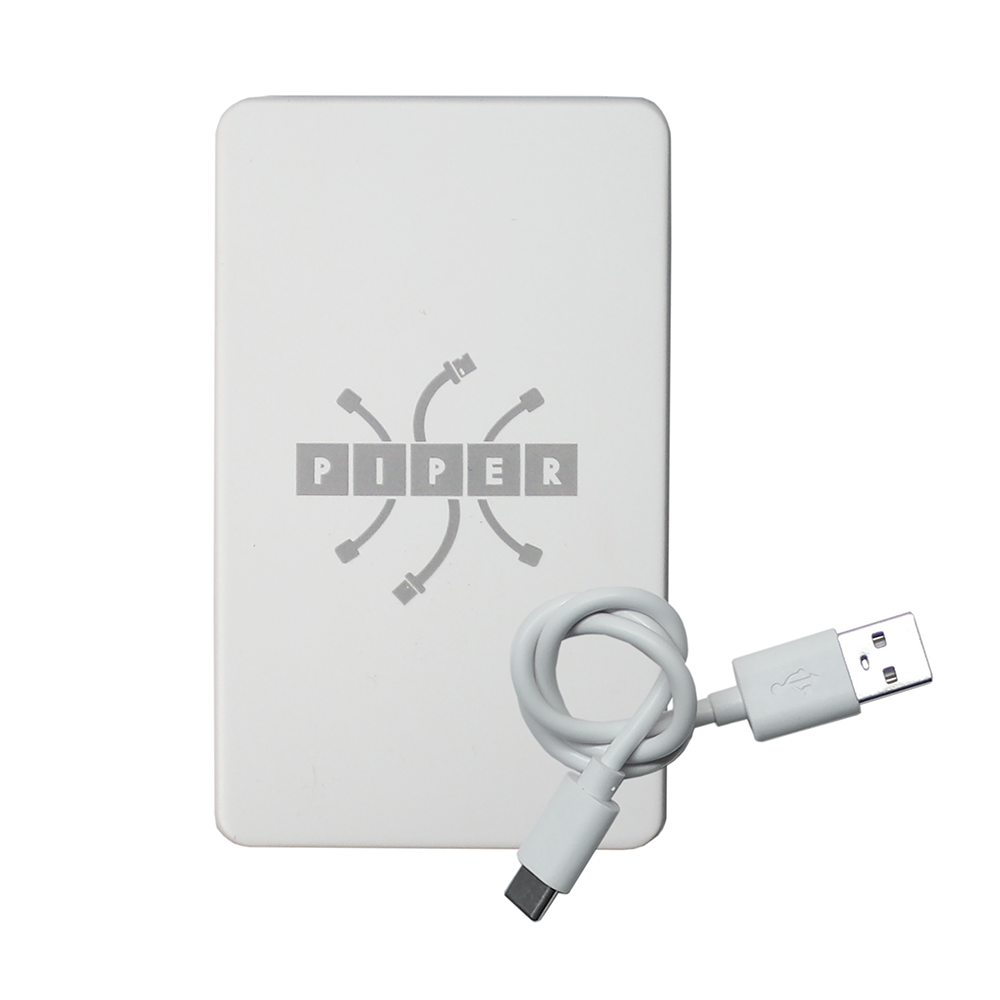SOLD 2022 - PRESENT
7" LCD Screen, speaker next to screen, acrylic toolboxSUPPORT
PIPER COMPUTER KIT V4
Version 4 of the Piper Computer Kit was shipped in late 2022. Some unique features to figure out if this is the kit you have:
- 7" LCD Screen
- Speaker next to Screen
- Acrylic Storage Box with Fold-Out Breadboards
Hardware Issues
How do I assemble my kit?
Use the blueprint to assemble your Piper Computer Kit V4. Use the video to see how the build looks!
My "C" screws aren't long enough on step 2.2?
If you are having trouble inserting the screws into the lip to attach the latch as shown here, you might have a defective 2-8 piece.
Specifically, the plunge cut where the nut sits had a slightly different shape in some runs. This prevents the nut from sitting flush and the C screws from reaching the nut.
CORRECT ASSEMBLY
Nut sits flat in plunge cut and screw inserts to hold latch.
DEFECTIVE ASSEMBLY
Nut cannot insert into plunge cut and C screw does not reach nut to screw in.
Luckily you can solve this with the pieces in your kit, by following these steps:
- Grab an "A" screw and insert that instead. This should be long enough to reach the nut on the other side.
- Screw in the nut, warping the wood to accomodate where the nut sits
- Remove the "A" screw
- Use the "C" screw to attach the latch as shown in the blueprint
What is the difference between Piper Computer Kit V4 and V4B?
The Piper Computer Kit V4 includes the Raspberry Pi 4 while the Piper Computer Kit V4B includes the Raspberry Pi 3 Model B+. The wiring for these kits are different from one another.
Depending on which kit you have, you will have different wires, so see the diagrams below:
Piper Computer Kit V4A Wiring
Piper Computer Kit V4B Wiring
What happens after I assemble my kit?
Instructions are part of the Piper Computer Kit experience!
After building the Piper Computer Kit, you'll start up your Piper Computer Kit, which will launch into our custom Minecraft StoryMode software.
Your instructions are inside the Minecraft games.
To access the instructions find the Crafting Table (blue block with an "i" for information, as shown below) within each game. Make sure to use your mouse scroll wheel to select the wrench from your inventory, then use your mouse to "right click" the Crafting Table. This will open up the "fancy schmancy digitizer" and provide instructions on how to wire up the hardware using breadboards, inputs, outputs and your Raspberry Pi.
To access the instructions find the Crafting Table (blue block with an "i" for information, as shown below) within each game. Make sure to use your mouse scroll wheel to select the wrench from your inventory, then use your mouse to "right click" the Crafting Table. This will open up the "fancy schmancy digitizer" and provide instructions on how to wire up the hardware using breadboards, inputs, outputs and your Raspberry Pi.
Below is the fancy schmancy digitizer which shows how the student should wire up their input or output from the breadboard to the Raspberry Pi. You will see these instructions when you click on the Crafting Table.
PiperCode, step-by-step instructions are on the right side of the screen for each project. The steps include building your hardware and code.
My kit doesn't match the pictures?
The purpose of the wooden overlay in Piper Computer Kit V1 and V2 was to guide the wiring of the five buttons. With the wood overlay, there was no ambiguity regarding where the wires or buttons were plugged into the breadboard.
However, we found that because of the overlay, kids were not actively thinking about where the wires had to plug in to complete the circuit. Namely, as there are parallel rails along the bottom of the breadboard, the wires MUST be plugged into the same rail as the button (see green wiring).
To encourage, more critical thinking regarding this important aspect of circuitry, we removed the wooden overlay over the controller in Piper Computer Kit V3 and V4.
Piper Computer Kit V2 Controller (With Overlay)
Piper Computer Kit V3 Controller (No Overlay)
To ensure that this was also clear in the game play, the software was modified to v2.7.1 which removes the wooden overlay from the hardware builds when clicking on the crafting table.
NOTE: The video graphics are NOT changed, so you may see wooden covers in the autoplayed videos but not in the hardware building workspace.
v2.7.0 Rendering
v2.7.1 Rendering
Ultimately, this change has allowed students to learn how the breadboard works through trial and error early in the Piper StoryMode process so they can build circuits more seamlessly later on.
What version of the Raspberry Pi is included in the Piper Computer Kit?
The wood design and the build process of the Piper Computer Kit V4 remains the same, however there will be multiple iterations of the kit with different Raspberry Pis as necessary due to availability.
Read more about Raspberry Pis on their site at: https://www.raspberrypi.com/products/
The versions are as follows:
- Piper Computer Kit V4 = Raspberry Pi 4 Model B+
- Piper Computer Kit V4B = Raspberry Pi 3 Model B+
- Piper Computer Kit V4A = Raspberry Pi 3 Model A+
How do I shut down my Piper Computer Kit V4?
Follow the steps in this Piper Computer Kit V2 video to see how to shut down the software and then unplug your battery to fully turn off your Piper Computer Kit V4 properly:
If you have a white battery with a gray Piper logo on it that looks like the following, you may notice some issues when pressing the power button on the side to turn the battery off. Namely you may notice that the red light on your Raspberry Pi remains on or that your speaker makes a soft "tik-tik" sound when the battery is off:
These issues are both due to the battery continuing to deliver a small voltage even when the power button has been pressed to turn it off. There is no danger with this and it only mildly drains the battery, but can be a bit of a nuisance, so be sure to unplug the battery to properly turn off your Piper Computer Kit.
I need replacement parts. What do I do?
We have limited replacement parts for sale on our website, please use the search icon in the upper right corner and search for the part you are interested in replacing.
If you have questions, please email hi@playpiper.com. If your Piper Computer is within the 1-year Warranty, please email hi@playpiper.com.
Software Issues
How do I update my software?
The highest level of software that works with the V4B is 2.8.2. We've written up instructions on how to access your software update here:
My Piper Computer Kit screen is only displaying blue to black?
So you have your Piper Computer Kit assembled, but when you try to turn it on the screen either goes from Blue to Black or says No Signal. Let’s go through some steps that could explain why your screen is acting up.
Check your Raspberry Pi for lights. A Raspberry Pi that is working correctly will have a solid red light and a blinking green light on the upper right area of the Raspberry Pi when powered on.
- If you do not see a red light this means your Pi is not getting power. There could be two main causes of this (a) the green cable between your battery and the Raspberry Pi is not working properly or (b) your battery is not providing power.
- If you have a red light, but no green light this means your Raspberry Pi is getting power, but it is not reading the SD Card.
- If you have a red light and a blinking green light, this means your Raspberry Pi is receiving power, but the screen is not getting a connection
If you do not see a red light
- If you have a Micro USB to USB cable that you can use let's see if that cable works. Plug the USB side into the Piper battery and the Micro USB to the Raspberry Pi. If the lights come on, the issue was your Harness Cable.
- If that did not work, the issue may be your battery. Check to make sure the battery is charged and is showing lights on the top of the battery when you turn it on. If no lights appear on the battery, try charging it. Alternatively, you may power your Piper Computer Kit from a wall outlet instead of the Piper battery. To do this you will need a long Micro USB to USB cable along with a wall adapter. If this method works, your battery may need to be replaced.
If you have a red light, but no green light
First, try pulling your SD Card out (it's underside the Raspberry Pi, on the right side near the battery) and re-inserting it a few times. This can clear any dust or grime off the connectors. After this, make sure your SD Card is firmly inserted into its slot.
If that doesn't work, follow this guide (Scroll down to the header titled, “Download and Install Piper SD Card Image”) on how to reflash your card and you should be up and on your way. If you are unable to flash your card, contact us at hi@playpiper.com to get this issue sorted out.
If you have a red light and a blinking green light
- Follow this helpful video and make sure all your connections are safe and secure.
- This issue is most commonly caused by the HDMI cable not being inserted all the way either at the Raspberry Pi or behind the screen where the HDMI connects to the screen driver board.
- If that doesn’t work, trying switching out your HDMI cable with another one you may have that you know works properly. If your new HDMI cable works, you need a new HDMI cable.
- If the HDMI cable did not solve your issue, try hooking your Piper Computer Kit to another display, such as a TV or computer monitor. If you see an image, this means your screen is the issue.
- If none of these options work, it may mean that the HDMI port on your Raspberry Pi is defective and needs to be replaced.
My Piper Computer Kit displays "No Signal" on the screen?
When powering on your Piper Computer Kit, if the screen displays "No Signal" read this article for troubleshooting.
If your screen display states "No Signal" this tells us that the screen has power from the battery but is not receiving a signal from the Raspberry Pi.
- Check all the connections from the back of the screen to the Raspberry Pi. Often times the connection on the back of the screen is not properly inserted which would cause this issue.
- If the connections all look good and you are still having the same issue and you have another HDMI cable, try switching out the Piper HDMI cable with a different HDMI cable and see if that works.
- If switching the HDMI cable does not work, try hooking the Piper Computer Kit up to a different display, such as a computer monitor or a TV. You simply would take an HDMI cable and go from the Raspberry Pip to your monitor or TV. If this fixes your problem, then there is an issue with your Piper Computer Kit screen. If that does not work you may have a defective port on your Raspberry Pi.
My Piper Computer Kit is stalled on the "boot up" screen with a bunch of lines of code?
When booting up your Piper Computer, we have seen issues with the boot up procedure stalling. Troubleshooting tips are below.
You assemble your Piper Computer Kit, and when you go to turn it on all you see is this funky looking code. This means your SD Card is possibly corrupt. What now?
Here are the troubleshooting steps you can go through to check it out.
- Find the SD Card on the right side of your Raspberry Pi and make sure it's securely pushed into the Raspberry Pi; check for dust, and try to reinsert it a few times.
- Try removing your SD Card and restarting your Piper Computer Kit. If your screen switches to saying "No Signal" or goes from a blue screen to a black screen, you may have a corrupted SD Card.
- Follow this guide (Scroll down to the header titled, “Download and Install Piper SD Card Image”) on how to reflash your card and you should be up and on your way. If you cannot do this, contact our customer support at hi@playpiper.com.
My Piper Computer Kit has an 8GB SD Card which doesn't allow me to update?
Our latest software requires a 16GB SD Card and the 2016 edition you purchased has an 8GB SD Card.
You may purchase a 16GB SD Card pre-loaded with our latest software through our online store.
USEFUL VIDEOS
Helpful videos for the Computer Kit V4
Build of Piper Computer Kit V4
Overview
Curriculum
Phase 1 - The Build
Phase 2 - StoryMode
Phase 3 - PiperCode
Phase 4/5 - Extending with Sensors
Conclusions




















